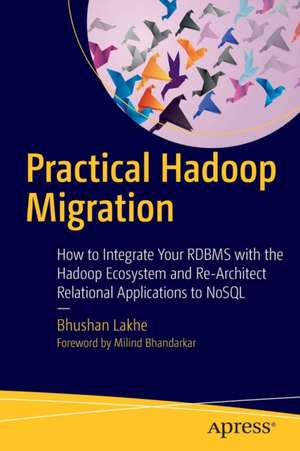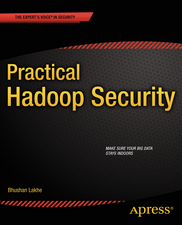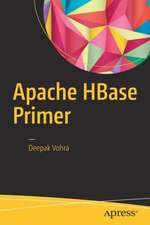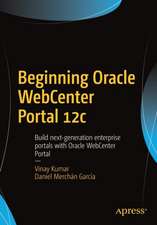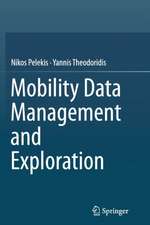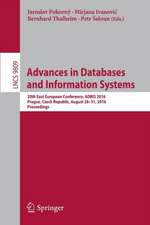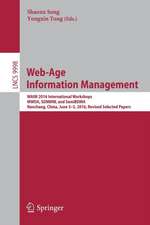Practical Hadoop Migration: How to Integrate Your RDBMS with the Hadoop Ecosystem and Re-Architect Relational Applications to NoSQL
Autor Bhushan Lakheen Limba Engleză Paperback – 11 aug 2016
Winner of IBM’s 2012 Gerstner Award for his implementation of big data and data warehouse initiatives and author of Practical Hadoop Security, author Bhushan Lakhe walks you through the entire transition process. First, he lays out the criteria for deciding what blend of re-architecting, migration, and integration between RDBMS and HDFS best meets your transition objectives. Then he demonstrates how to design your transition model.
Lakhe proceeds to cover the selection criteria for ETL tools, the implementation steps for migration with SQOOP- and Flume-based data transfers, and transition optimization techniques for tuning partitions, scheduling aggregations, and redesigning ETL. Finally, he assesses the pros and cons of data lakes and Lambda architecture as integrative solutions and illustrates their implementation with real-world case studies.
Hadoop/NoSQL solutions do not offer by default certain relational technology features such as role-based access control, locking for concurrent updates, and various tools for measuring and enhancing performance. Practical Hadoop Migration shows how to use open-source tools to emulate such relational functionalities in Hadoop ecosystem components.
What You'll Learn
- Decide whether you should migrate your relational applications to big data technologies or integrate them
- Transition your relational applications to Hadoop/NoSQL platforms in terms of logical design andphysical implementation
- Discover RDBMS-to-HDFS integration, data transformation, and optimization techniques
- Consider when to use Lambda architecture and data lake solutions
- Select and implement Hadoop-based components and applications to speed transition, optimize integrated performance, and emulate relational functionalities
Database developers, database administrators, enterprise architects, Hadoop/NoSQL developers, and IT leaders. Its secondary readership is project and program managers and advanced students of database and management information systems.
Preț: 277.27 lei
Preț vechi: 346.59 lei
-20% Nou
Puncte Express: 416
Preț estimativ în valută:
53.05€ • 55.39$ • 43.91£
53.05€ • 55.39$ • 43.91£
Carte tipărită la comandă
Livrare economică 05-19 aprilie
Preluare comenzi: 021 569.72.76
Specificații
ISBN-13: 9781484212882
ISBN-10: 1484212886
Pagini: 350
Ilustrații: XXIV, 305 p. 99 illus., 61 illus. in color.
Dimensiuni: 155 x 235 x 23 mm
Greutate: 0.47 kg
Ediția:1st ed.
Editura: Apress
Colecția Apress
Locul publicării:Berkeley, CA, United States
ISBN-10: 1484212886
Pagini: 350
Ilustrații: XXIV, 305 p. 99 illus., 61 illus. in color.
Dimensiuni: 155 x 235 x 23 mm
Greutate: 0.47 kg
Ediția:1st ed.
Editura: Apress
Colecția Apress
Locul publicării:Berkeley, CA, United States
Public țintă
Professional/practitionerCuprins
Chapter 1: RDBMS Meets Hadoop: Integrating, Re-Architecting, and Transitioning.- Part I: Relational Database Management Systems: A Review of Design Principles, Models, and Best Practices.- Chapter 2: Understanding RDBMS Design Principles.- Chapter 3: Using SSADM for Relational Design.- Chapter 4: RDBMS Design and Implementation Tools.-Part II: Hadoop: A Review of the Hadoop Ecosystem, NoSQL Design Principles and Best Practices.- Chapter 5: The Hadoop Ecosystem.- Chapter 6: Re-Architecting for NoSQL Design Principles, Models, and Best Practices.-Part III: Integrating Relational Database Management Systems with the Hadoop Distributed File System.- Chapter 7: Data Lake Integration Design Principles.- Chapter 8: Implementing SQOOP and Flume-based Data Transfers.-Part IV: Transitioning from Relational to NoSQL Design Models.- Chapter 9: Lambda Architecture for Real-time Hadoop Applications.- Chapter 10: Implementing and Optimizing the Transition.- Part V: Case Study for Designing and Implementing a Hadoop-based Solution.- Chapter 11: Case Study: Implementing Lambda Architecture.
Notă biografică
Bhushan Lakhe is Senior Vice President of Information and Data Architecture at Ipsos, a global market research company headquartered in Paris. He has more than 25 years experience in software development life cycle management, enterprise architecture design and framework implementation, service management, data warehousing, and Hadoop ecosystem (HDFS, HBase, Hive, Pig, SQOOP, MongoDB) implementation, having worked successively at Tata Consultancy Services, Fujitsu-ICIM, ICL, IBM, Unisys Corporation, and as a database architecture consultant to such clients as Leo Burnett, ABN AMRO Bank, Abbott Laboratories, Motorola, JPMorgan Chase, and British Petroleum. He received IBM’s 2012 Gerstner Award for his implementation of major big data and data warehouse projects. Lakhe is a Cloudera Certified Administrator for Apache Hadoop CDH4 and a Microsoft Certified Technology Specialist, SQL Server Implementation and Maintenance. He is the author of Practical Hadoop Security. He is active in the Chicago Hadoop community and as a speaker at technical meetups and industry conferences. Lakhe graduated from the Birla Institute of Technology and Science, Pilani.
Caracteristici
Covers the requirements and design methodologies of relational data and NoSQL models. Written by an acknowledged Hadoop expert. Contains many different examples from the Hadoop ecosystem.
